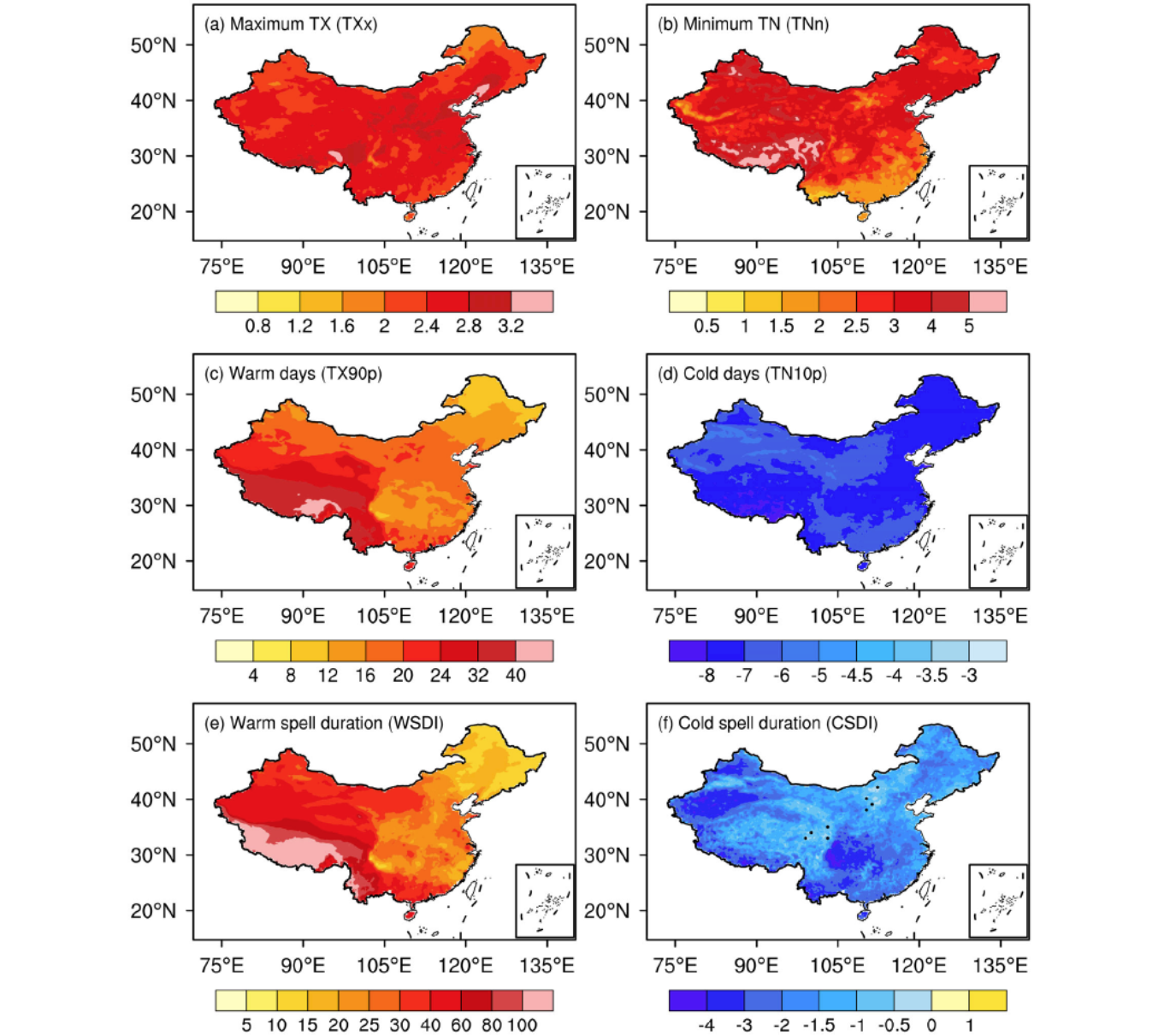联系我们
竺可桢-南森国际研究中心
邮 箱:[email protected]
邮 编:100029
地 址:北京市朝阳区德胜门外祁家豁子华严里40号 竺南中心

科研进展
Research Progress基于四套动力降尺度模拟的中国极端高低温事件的评估和集合预估
Evaluation and ensemble projection of extreme high and low temperature events in China from four dynamical downscaling simulations
[2021-01-31]
【中文介绍】
极端气候事件与气象和水文灾害紧密相关,因此受到了广泛的关注。我们利用四套动力降尺度模拟数据,对中国极端气候事件的未来变化进行了研究。主要结果包括:(1)区域模式能合理模拟中国区域最高温度(TXx)和最低温度(TNn)的空间分布,但对暖日(TX90p)和冷夜(TN10p)指数的模拟能力较弱。(2)区域模式降尺度能明显减小不同全球模式结果之间的差异。(3)不同区域模式的结果在中国西部具有明显差异,表明在这些区域预估结果具有较大模式依赖性。(4)区域模式预估的未来极端气候变化幅度相对对应的全球模式较弱。(5)相对1986–2005年,到2079–2098年区域模式集合预估的TXx、TX90p和TNn将分别增加2.5°C、21.1%和3.3°C, TN10p将减少6.8%。
【英文介绍】
Extreme climate events are often of great interest because of their close relationship with meteorological and hydrological disasters. In this study, four RCM simulations driven by different GCMs (CSIRO-Mk3.6.0, EC-EARTH, HadGEM2-ES, and MPI-ESM-MR) are used as an ensemble to project changes in extreme high and low temperatures in China as represented by selected Expert Team on Climate Change Detection indices. Each simulation is performed at 25 km resolution from 1980 to 2099 using RegCM4.4 RCM. Results show the following: (a) All four reasonably reproduce climatological maximum daily maximum temperature (TX), warm spell duration, minimum daily minimum temperature (TN), and cold spell duration, but the majority shows relatively weak ability to capture climatological warm day and cold night frequencies. (b) Although the RCM homogenizes much of the variance originally shown between driving GCM simulations, marked dissimilarities are still shown in western China across the four downscaling simulations, implying a dependency on the individual GCM-driven RCM simulation for this region. (c) All of China shows an increase in maximum TX, warm days, warm spell duration, minimum TN, and a decrease in cold nights and cold spell duration, during the near-term, middle-term, and long-term. The Tibetan Plateau and its adjacent regions show more significant changes in extreme temperature, indicating stronger sensitivity to changes in extremes. RCM downscaling projects less significant change in extreme temperatures than the driving GCM. (d) The ensemble of RCM simulations projects that area-averaged maximum TX, warm days, warm spell duration, and minimum TN increase over China as a whole by 2.5 °C, 21.1%, 43.6 days, and 3.3 °C, respectively, while cold nights and cold spell duration decrease by 6.8% and 2.0 days, respectively during the long-term under the RCP4.5 scenario relative to 1986–2005. Future episodes of extreme high temperature are likely to require more research as they become more common.
【关键图表】

【引用格式】
Guo Donglin, Zhang Ying, Gao Xuejie, Pepin Nick, Sun Jianqi, 2021: Evaluation and ensemble projection of extreme high and low temperature events in China from four dynamical downscaling simulations. International Journal of Climatology, 41, E1252–E1269.